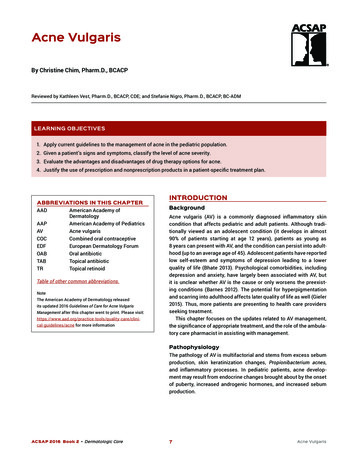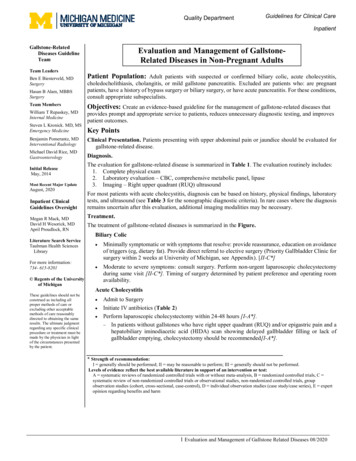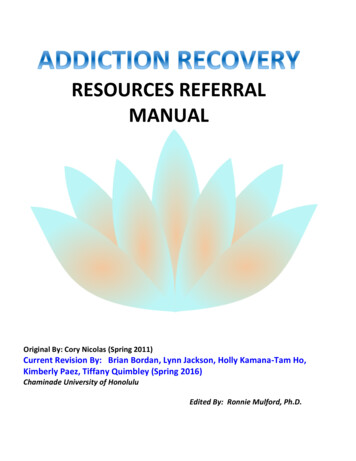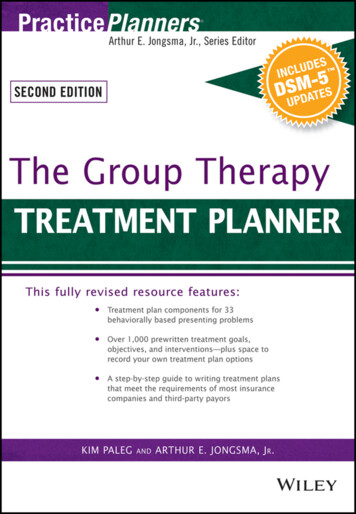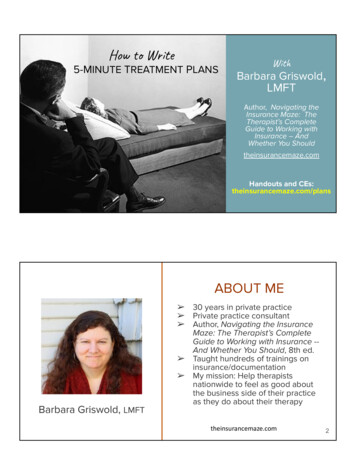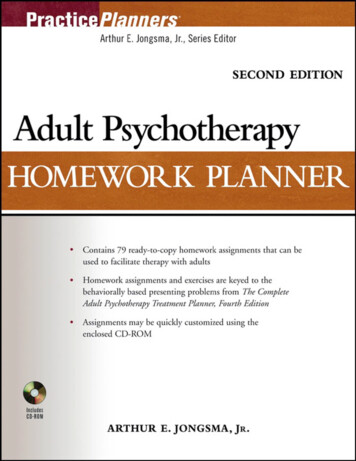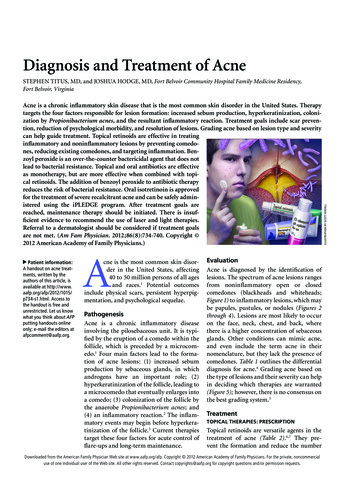
Transcription
Diagnosis and Treatment of AcneAcne is a chronic inflammatory skin disease that is the most common skin disorder in the United States. Therapytargets the four factors responsible for lesion formation: increased sebum production, hyperkeratinization, colonization by Propionibacterium acnes, and the resultant inflammatory reaction. Treatment goals include scar prevention, reduction of psychological morbidity, and resolution of lesions. Grading acne based on lesion type and severitycan help guide treatment. Topical retinoids are effective in treatinginflammatory and noninflammatory lesions by preventing comedones, reducing existing comedones, and targeting inflammation. Benzoyl peroxide is an over-the-counter bactericidal agent that does notlead to bacterial resistance. Topical and oral antibiotics are effectiveas monotherapy, but are more effective when combined with topical retinoids. The addition of benzoyl peroxide to antibiotic therapyreduces the risk of bacterial resistance. Oral isotretinoin is approvedfor the treatment of severe recalcitrant acne and can be safely administered using the iPLEDGE program. After treatment goals arereached, maintenance therapy should be initiated. There is insufficient evidence to recommend the use of laser and light therapies.Referral to a dermatologist should be considered if treatment goalsare not met. (Am Fam Physician. 2012;86(8):734-740. Copyright 2012 American Academy of Family Physicians.) Patient information:A handout on acne treatments, written by theauthors of this article, isavailable at http://www.aafp.org/afp/2012/1015/p734-s1.html. Access tothe handout is free andunrestricted. Let us knowwhat you think about AFPputting handouts onlineonly; e-mail the editors atafpcomment@aafp.org.Acne is the most common skin disorder in the United States, affecting40 to 50 million persons of all agesand races.1 Potential outcomesinclude physical scars, persistent hyperpigmentation, and psychological sequelae.PathogenesisAcne is a chronic inflammatory diseaseinvolving the pilosebaceous unit. It is typified by the eruption of a comedo within thefollicle, which is preceded by a microcomedo.1 Four main factors lead to the formation of acne lesions: (1) increased sebumproduction by sebaceous glands, in whichandrogens have an important role; (2)hyperkeratinization of the follicle, leading toa microcomedo that eventually enlarges intoa comedo; (3) colonization of the follicle bythe anaerobe Propionibacterium acnes; and(4) an inflammatory reaction.2 The inflammatory events may begin before hyperkeratinization of the follicle.3 Current therapiestarget these four factors for acute control offlare-ups and long-term maintenance.EvaluationAcne is diagnosed by the identification oflesions. The spectrum of acne lesions rangesfrom noninflammatory open or closedcomedones (blackheads and whiteheads;Figure 1) to inflammatory lesions, which maybe papules, pustules, or nodules (Figures 2through 4). Lesions are most likely to occuron the face, neck, chest, and back, wherethere is a higher concentration of sebaceousglands. Other conditions can mimic acne,and even include the term acne in theirnomenclature, but they lack the presence ofcomedones. Table 1 outlines the differentialdiagnosis for acne.4 Grading acne based onthe type of lesions and their severity can helpin deciding which therapies are warranted(Figure 5); however, there is no consensus onthe best grading system.5TreatmentTOPICAL THERAPIES: PRESCRIPTIONTopical retinoids are versatile agents in thetreatment of acne (Table 2).6,7 They prevent the formation and reduce the numberDownloaded from the American Family Physician Web site at www.aafp.org/afp. Copyright 2012 American Academy of Family Physicians. For the private, noncommercial734 AmericanPhysicianwww.aafp.org/afpNumber8 requests.October 15, 2012use of oneFamilyindividualuser of the Web site. All other rights reserved.Contact copyrights@aafp.org for copyrightVolumequestions86,and/orpermission ILLUSTRATION BY SCOTT BODELLSTEPHEN TITUS, MD, and JOSHUA HODGE, MD, Fort Belvoir Community Hospital Family Medicine Residency,Fort Belvoir, Virginia
AcneFigure 3. Moderate inflammatory acne lesions with comedones, several papules and pustules, and few nodules.Figure 1. Noninflammatory acne lesions consisting ofopen and closed comedones.Figure 2. Mild inflammatory acne lesions with comedonesand few papules and pustules.of comedones, making them useful againstnoninflammatory lesions. Topical retinoidsalso possess anti-inflammatory properties, making them somewhat useful in thetreatment of inflammatory lesions.6 Topicalretinoids are indicated as monotherapy fornoninflammatory acne and as combinationtherapy with antibiotics to treat inflammatory acne. Additionally, they are useful formaintenance after treatment goals have beenreached and systemic drugs are discontinued.2 Overall, adapalene (Differin) is thebest tolerated topical retinoid. Limited evidence suggests that tazarotene (Tazorac) ismore effective than adapalene and tretinoin(Retin-A). There is no evidence that any formulation is superior to another.6Topical antibiotics are used predominantly for the treatment of mild to moderateinflammatory or mixed acne. Clindamycin and erythromycin are the most studied (Table 3).2,5,7 They are sometimes usedOctober 15, 2012 Volume 86, Number 8Figure 4. Severe inflammatory acne lesions with comedones, several papules and pustules, multiple nodules, andscarring.Table 1. Differential Diagnosis of AcneDiagnosisDistinguishing t eruption; spreads with scratching or shaving;variable distributionUse of androgens, adrenocorticotropic hormone,bromides, corticosteroids, oral contraceptives,iodides, isoniazid, lithium, phenytoin (Dilantin)Double comedo; starts as a painful boil; sinus atitis“Heat rash” in response to exertion or heat exposure;nonfollicular papules, pustules, and vesiclesPapules and pustules confined to the chin and nasolabialfolds; clear zone around the vermilion borderAffects curly-haired persons who regularly shavecloselyErythema and telangiectasias; no comedonesGreasy scales and yellow-red coalescing macules orpapulesInformation from reference 4.www.aafp.org/afp American Family Physician 735
AcneManagement of AcneDetermine lesion type and severityComedonesMild inflammatorypapules and pustulesModerate inflammatory papulesand pustules few nodulesSevere inflammatory papulesand pustules multiple nodulesTopical retinoidNoEffective?Topical retinoid plusbenzoyl peroxideYesEffective?Maintenance therapy:topical retinoidNodulesPapules and pustulesNodulesPapules and pustulesTopical retinoid plus benzoylperoxide plus topical antibioticOral isotretinoinTopical retinoid plusbenzoyl peroxideplus oral antibioticNoYesMaintenance therapy:topical retinoidEffective?Maintenance therapy: topicalretinoid plus benzoyl peroxideNoTopical retinoid plusbenzoyl peroxideplus oral antibioticorYesMaintenance therapy:topical retinoidTopical retinoid plus benzoylperoxide plus topical antibioticMaintenance therapy: topicalretinoid plus benzoyl peroxideFigure 5. Severity-based approach to treating acne.as monotherapy, but are more effective in combination with topical retinoids.5 Because of the possibility that topical antibiotics may induce resistance, it isrecommended that benzoyl peroxide be added to theseregimens.2Table 4 summarizes the additional topical therapiesthat are available.5,8-11Azelaic acid should be consideredfor use in pregnant women. The cream formulation(Azelex) is approved by the U.S Food and Drug Administration (FDA) for the treatment of acne vulgaris, butthe gel (Finacea) has significantly better bioavailability.8It has mixed antimicrobial and anticomedonal effects,Table 2. Selected Topical Retinoids for the Treatment of Acne VulgarisAgentAdapalene(Differin)FDA pregnancycategoryCEstimated cost generic(brand)*Adverse effectsAvailable formulationsLocal erythema, peeling,dryness, pruritus, stingingCream, lotion (0.1%)Gel (0.1%, 0.3%)Adapalene/benzoyl peroxide(Epiduo) gel (0.1%/2.5%) 125 ( 363)NA ( 269)Tazarotene(Tazorac)XLocal erythema, peeling,dryness, pruritus, stingingCream, gel (0.05%, 0.1%)NA ( 240)Tretinoin(Retin-A)CLocal erythema, peeling,dryness, pruritus, stingingCream (0.025%, 0.05%, 0.1%)Gel (0.01%, 0.025%, 0.05%)Microsphere gel (0.04%, 0.1%) 27 ( 130) 24 ( 19 to 105)NA ( 170)FDA U.S. Food and Drug Administration; NA not available.*—Estimated retail price of one month’s treatment based on information obtained at http://www.lowestmed.com (accessed September 18, 2012).Information from references 6 and 7.736 American Family Physicianwww.aafp.org/afpVolume 86, Number 8 October 15, 2012
AcneTable 3. Selected Topical Antibiotics for the Treatment of Acne VulgarisAgentFDA erse effectsAvailable formulationsEstimated cost generic (brand)*Local erythema, peeling,dryness, pruritus,burning, oilinessFoam, gel, lotion, solution(1.0%)Clindamycin/benzoyl peroxide(Benzaclin) gel (1%/5%,1.2%/2.5%)Clindamycin/tretinoin gel(Veltin, Ziana; 1.2%/0.025%)Gel, solution, ointment (2%)Erythromycin/benzoyl peroxide(Benzamycin) gel (3%/5%) 12 to 96, depending onformulation ( 46 to 213) 107 ( 210)Local erythema, peeling,dryness, pruritus,burning, oilinessNA ( 180 Veltin, 250 Ziana) 25 (NA) 62 ( 313)Topical antibiotics are more effective when combined with a topical retinoid.FDA U.S. Food and Drug Administration; NA not available.*—Estimated retail price of one month’s treatment based on information obtained at http://www.lowestmed.com (accessed September 18, 2012).Information from references 2, 5, and 7.and may be effective for the treatment of mild to moderate inflammatory or mixed acne.5Dapsone is the first agent in a new class of topicalacne medications to achieve FDA approval in the past10 years.9 Although it is an antibiotic, it likely improvesacne by inhibiting inflammation. In studies, dapsonewas minimally more effective than placebo in reducing inflammatory and noninflammatory lesions, but ithas never been compared with other topical agents.10Unlike oral dapsone, there is no evidence that thetopical formulation causes hemolytic anemia or severeskin reactions.9TOPICAL THERAPIES: OVER THE COUNTERBenzoyl peroxide is an over-the-counter bactericidalagent that comes in a wide array of concentrations andformulations. No particular form has been proven better than another.5 Benzoyl peroxide is unique as an antimicrobial because it is not known to increase bacterialresistance.11 It is most effective for the treatment of mildTable 4. Selected Nonantibiotic Topical Therapies for the Treatment of Acne VulgarisAgentFDA pregnancycategoryAzelaic acidEstimated cost generic(brand)*Adverse effectsAvailable formulationsBHypopigmentation,burning, stinging,tingling, pruritusCream (Azelex, 20%; approved for acnevulgaris)Gel (Finacea, 15%; approved for rosacea)NA ( 210)BenzoylperoxideCDry skin, localerythemaBar, cream, gel, lotion, pad, wash(2.5% to 10%) 5 over the counter 8 to 36 prescription(NA)DapsoneCLocal oiliness, peeling,dryness, erythemaGel (Aczone, 5%)NA ( 193)Salicylic acidCDryness, mild skinirritationCream, dressing, foam, gel, liquid, lotion,ointment, pad, paste, shampoo, soap,solution, stick (0.5% to 3%) 5 over the counterFDA U.S. Food and Drug Administration; NA not available.*—Estimated retail price of one month’s treatment based on information obtained at http://www.lowestmed.com and http://www.drugstore.com(accessed September 18, 2012).Information from references 5, and 8 through 11.October 15, 2012 Volume 86, Number 8www.aafp.org/afp American Family Physician 737
AcneTable 5. Selected Oral Antibiotics for the Treatment of Acne VulgarisAgentFDA pregnancycategoryDoxycyclineEstimated costgeneric (brand)*Adverse effectsDosageDPhotosensitivity, pseudotumor cerebri,esophageal irritation50 to 100 mg once ortwice per day 15 ( 71 to 363)ErythromycinBGastrointestinal upset250 to 500 mg two tofour times per day 73 to 340 (NA)Minocycline(Minocin)DVestibular dysfunction, photophobia,hepatotoxicity, lupus-like reaction,pseudotumor cerebri50 to 100 mg once ortwice per day 21 to 59 ( 173 to 675)TetracyclineCGastrointestinal upset, photosensitivity,pseudotumor cerebri250 to 500 mg onceor twice per day 8 (NA)Trimethoprim/sulfamethoxazole(Bactrim, Septra)CAllergic reactions160/800 mg twiceper day 33( 194)FDA U.S. Food and Drug Administration; NA not available.*—Estimated retail price of one month’s treatment based on information obtained at http://www.lowestmed.com (accessed September 18, 2012).Information from references 2, 5, 10, and 12.to moderate mixed acne when used in combination withtopical retinoids.2 Benzoyl peroxide may also be addedto regimens that include topical and oral antibiotics todecrease the risk of bacterial resistance.2Salicylic acid is present in a variety of over-the-countercleansing products. These products have anticomedonalproperties and are less potent than topical retinoids, butthere have been only limited high-quality studies examining their effectiveness.5ORAL THERAPIESOral antibiotics are effective for the treatment of moderate to severe acne5 (Table 5 2,5,10,12). The best-studied antibiotics include tetracycline and erythromycin. Based onexpert consensus on relative effectiveness, the AmericanAcademy of Dermatology recommends using doxycyclineand minocycline (Minocin) rather than tetracycline.5Trimethoprim/sulfamethoxazole (Bactrim, Septra) andtrimethoprim alone may be used if tetracycline or erythromycin cannot be tolerated. Because of the potential forbacterial resistancewith the use of anTopical dapsone is the firstoral antibiotic, itdrug in a new class of acneis recommendedtherapy to receive approvalthat benzoyl perin the past 10 years.oxide be added toany regimen of oralantibiotics.2 Tetracycline is preferred over erythromycinbecause of the higher rates of resistance associated witherythromycin.5After individual treatment goals have been met, oralantibiotics can be discontinued and replaced with topical738 American Family Physicianretinoids for maintenance therapy.2 Topical retinoids aresufficient to prevent relapses in most patients with acnevulgaris, especially if the disease was originally classifiedas mild or moderate. If the patient’s acne was initiallyclassified as severe inflammatory, benzoyl peroxide withor without an antibiotic can be added for maintenancetherapy.2Oral isotretinoin is FDA-approved for the treatmentof severe recalcitrant acne. Evidence suggests that it isalso useful for less severe acne that is treatment resistant.5 The usual dosage for severe treatment-resistantacne is 0.5 to 1.0 mg per kg per day for about 20 weeks,or a cumulative dose of 120 mg per kg.13 Initial flareups can be minimized with a beginning daily dosage of0.5 mg or less per kg.5 Total cumulative doses of lessthan 120 mg increase relapse rates, and doses of morethan 150 mg increase the incidence of adverse effectswithout producing greater benefits.13 Approximately40 percent of patients achieve long-term remission with a120-mg cumulative dose, 40 percent require retreatmentwith topical therapy or oral antibiotics, and 20 percentrequire retreatment with isotretinoin.14,15 Patients withmoderate acne may respond to lower dosages (0.3 mgper kg per day) and experience fewer adverse effects.16Physicians, distributors, pharmacies, and patients mustregister in the iPLEDGE program (http://www.ipledgeprogram.com) before using isotretinoin. This programwas established to prevent pregnancy in patients takingthe medication. Isotretinoin is a potent teratogen andis associated with abnormalities of the face, eyes, ears,skull, central nervous system, cardiovascular system,thymus, and parathyroid glands. Negative pregnancywww.aafp.org/afpVolume 86, Number 8 October 15, 2012
AcneSORT: KEY RECOMMENDATIONS FOR PRACTICEClinical recommendationTopical retinoids are effective in the treatmentof noninflammatory and inflammatory acne.Oral antibiotics are effective for the treatmentof moderate to severe acne.Benzoyl peroxide should be used inconjunction with topical and oral antibioticsto reduce the risk of bacterial resistance.After treatment goals are reached, oralantibiotics should be replaced with topicalretinoids for maintenance therapy.Topical antibiotics are more effective whenused in conjunction with topical retinoids.Combined oral contraceptives can be used totreat inflammatory and noninflammatoryacne.EvidenceratingReferencesA2, 5, 6A2, 5C2C2A2, 5systematic review found insufficient evidence to recommend the use of spironolactone for the treatment of acne.20 Commonadverse effects include menstrual irregularities and breast tenderness. It is a potassium-sparing diuretic and may cause severehyperkalemia. Additionally, it is a potentialteratogen.21LASER AND LIGHT THERAPIESLight and laser therapies can be used for thetreatment of acne. Examples include visiblelight, pulsed-dye laser, and photodynamictherapies. There is insufficient evidence torecommend the routine use of these therapiesA consistent, good-quality patient-oriented evidence; B inconsistent or limitedquality patient-oriented evidence; C consensus, disease-oriented evidence, usualfor the treatment of acne.2 Studies of thesepractice, expert opinion, or case series. For information about the SORT evidenceproducts typically lack controls, have smallrating system, go to http://www.aafp.org/afpsort.xml.sample sizes, are short term, and do not compare these therapies with validated pharmatests are mandated before starting therapy, then monthly cologic treatments. There are no established guidelinesbefore receiving a prescription refill, immediately after on the optimal dosing, device, timing, and frequency totaking the last dose, and one month after taking the be used.22last dose. The use of isotretinoin has been suggested toworsen depression and increase the risk of suicide, but OTHER THERAPIESno causal relationship has been established.5 Required Table 6 summarizes other therapies that are used in thelaboratory monitoring during therapy includes a com- treatment of acne, with varying levels of evidence to supplete blood count, fasting lipid panel, and measure- port their use.5,23-26ment of liver transaminase levels. Commonadverse effects include headaches, dry skinand mucous membranes, and gastrointestiTable 6. Miscellaneous Therapies for the Treatmentnal upset.17of AcneSeveral estrogen-containing oral contraceptives are FDA-approved for the treatmentTherapyEvidenceof acne.17 These agents generally are considAcupunctureAh-shi acupuncture is no better than generalered second-line therapies, but they may beacupuncture treatmentconsidered first-line treatments in womenAvoidance of chocolateNo evidence of effectivenesswith adult-onset acne or perimenstrual flareor sugar consumptionups.18 A 2009 Cochrane review found thatBiofeedbackMay enhance response to medical treatmentthese agents are effective in reducing inflamfor acnematory and noninflammatory lesions.19Chemical peel (glycolic/No studies of effectivenesssalicylic acid)However, there is insufficient evidence toComedo removalMay help with treatment-resistant comedonesrecommend one agent over another, includand provide short-term reductions in theing those that are FDA approved versus thosenumber of noninflammatory lesionsthat are not. There is also no evidence to supIntralesional steroidsMay improve individual large cystic lesions5port their use over other studied therapies.MicrodermabrasionNo evidence of effectivenessSpironolactone (Aldactone) is an androTea tree (MelaleucaEffective for total lesion reduction of papules,gen receptor antagonist with unclear effecalternifolia) oilpustules, and comedones in mild totiveness in the treatment of acne. It is usuallymoderate acnereserved as a second- or third-line agent, orInformation from references 5, and 23 through 26.as an alternative to isotretinoin for womenwho cannot use this medication. A 2009October 15, 2012 Volume 86, Number 8A19www.aafp.org/afp American Family Physician 739
AcneReassessment and ReferralTreatment goals in patients with acne include the prevention of scars, the reduction of psychological morbidity,and the resolution of noninflammatory and inflammatory lesions. Therapy should be continued for a minimum of eight weeks before a treatment response can beaccurately assessed. Referral to a dermatologist shouldbe considered when treatment goals are not met or whenthere is significant scarring.27Data Sources: We performed electronic searches of PubMed, theCochrane database, Essential Evidence Plus, and the National GuidelineClearinghouse using the MESH terms acne, vulgaris, treatment, treat,and therapy. Search date: March 2011.The opinions and assertions contained herein are the private views of theauthors and are not to be construed as official, or as reflecting the viewsof the U.S. Army Medical Corps or the U.S. Army at large.6. Thielitz A, Abdel-Naser MB, Fluhr JW, Zouboulis CC, Gollnick H. Topicalretinoids in acne—an evidence-based overview. J Dtsch Dermatol Ges.2008;6(12):1023-1031.7. Hamilton RJ. Tarascon Pocket Pharmacopoeia. Sudbury, Mass.: Jones &Bartlett; 2011.8. Frampton JE, Wagstaff AJ. Azelaic acid 15% gel: in the treatment ofpapulopustular rosacea. Am J Clin Dermatol. 2004;5(1):57-64.9. New drugs: Aczone (dapsone) gel 5% [subscription required]. Pharmacist’s Letter/Prescriber’s Letter. 2009;25(1):250112.10. Draelos Z, Carter E, Maloney JM, et al.; United States/Canada DapsoneGel Study Group. Two randomized studies demonstrate the efficacy andsafety of dapsone gel, 5% for the treatment of acne vulgaris. J Am AcadDermatol. 2007;56(3):439.e1-439.e10.11. Thiboutot D, Zaenglein A, Weiss J, Webster G, Calvarese B, Chen D.An aqueous gel fixed combination of clindamycin phosphate 1.2% andbenzoyl peroxide 2.5% for the once-daily treatment of moderate tosevere acne vulgaris: assessment of efficacy and safety in 2813 patients.J Am Acad Dermatol. 2008;59(5):792-800.12. Simonart T, Dramaix M, De Maertelaer V. Efficacy of tetracyclines in thetreatment of acne vulgaris: a review. Br J Dermatol. 2008;158(2):208-216.13. Strauss JS, Rapini RP, Shalita AR, et al. Isotretinoin therapy for acne:results of a multicenter dose-response study. J Am Acad Dermatol.1984;10(3):490-496.Figures 1 through 4 provided by Melissa Scorza, MD.The AuthorsSTEPHEN TITUS, MD, is a faculty member at the National Capital Consortium Fort Belvoir (Va.) Community Hospital Family Medicine Residency,and an assistant professor of family medicine at the Uniformed ServicesUniversity of the Health Sciences, Bethesda, Md.JOSHUA HODGE, MD, is the associate program director of the NationalCapital Consortium Fort Belvoir Community Hospital Family MedicineResidency, and an assistant professor of family medicine at the UniformedServices University of the Health Sciences.Address correspondence to Stephen Titus, MD, Fort Belvoir Community Hospital, 9501 Farrell Rd., Fort Belvoir, VA 22060 (e-mail:stephen.j.titus2@us.army.mil). Reprints are not available from theauthors.14. White GM, Chen W, Yao J, Wolde-Tsadik G. Recurrence rates after thefirst course of isotretinoin. Arch Dermatol. 1998;134(3):376-378.15. Layton AM, Stainforth JM, Cunliffe WJ. Ten years’ experience of oralisotretinoin for the treatment of acne vulgaris. J Dermatol Treat. 1993;4(suppl 2):S2-S5.16. Amichai B, Shemer A, Grunwald MH. Low-dose isotretinoin in the treatment of acne vulgaris. J Am Acad Dermatol. 2006;54(4):644-646.17. James WD. Clinical practice. Acne. N Engl J Med. 2005;352(14):14631472.18. Katsambas AD, Dessinioti C. Hormonal therapy for acne: why not as firstline therapy? Facts and controversies. Clin Dermatol. 2010;28(1):17-23.19. Arowojolu AO, Gallo MF, Lopez LM, Grimes DA, Garner SE. Combinedoral contraceptive pills for treatment of acne. Cochrane Database SystRev. 2009;(3):CD004425.Author disclosure: No relevant financial affiliations to disclose.20. Brown J, Farquhar C, Lee O, Toomath R, Jepson RG. Spironolactone versus placebo or in combination with steroids for hirsutism and/or acne.Cochrane Database Syst Rev. 2009;(2):CD000194.REFERENCES21. Aldactone [package insert]. New York, NY: Pfizer Inc.; 2011. http://labeling.pfizer.com/ShowLabeling.aspx?id 520. Accessed June 29, 2012.1. White GM. Recent findings in the epidemiologic evidence, classification, andsubtypes of acne vulgaris. J Am Acad Dermatol. 1998;39(2 pt 3):S34-S37.2. Thiboutot D, Gollnick H, Bettoli V, et al. New insights into the management of acne: an update from the Global Alliance to Improve Outcomesin Acne group. J Am Acad Dermatol. 2009;60(5 suppl):S1-S50.22. Hamilton FL, Car J, Lyons C, Car M, Layton A, Majeed A. Laser and otherlight therapies for the treatment of acne vulgaris: systematic review. BrJ Dermatol. 2009;160(6):1273-1285.23. Karimipour DJ, Karimipour G, Orringer JS. Microdermabrasion: an evidence-based review. Plast Reconstr Surg. 2010;125(1):372-377.3. Jeremy AH, Holland DB, Roberts SG, Thomson KF, Cunliffe WJ. Inflammatory events are involved in acne lesion initiation. J Invest Dermatol.2003;121(1):20-27.24. Magin P, Pond D, Smith W, Watson A. A systematic review of the evidence for ‘myths and misconceptions’ in acne management: diet, facewashing and sunlight. Fam Pract. 2005;22(1):62-70.4. Acne vulgaris (common acne) and cystic acne. In: Wolff K, Fitzpatrick TB,Johnson RA, eds. Fitzpatrick’s Color Atlas and Synopsis of Clinical Dermatology. 6th ed. New York, NY: McGraw-Hill; 2009:2-6.25. Son BK, Yun Y, Choi IH. Efficacy of ah shi point acupuncture on acnevulgaris. Acupunct Med. 2010;28(3):126-129.5. Strauss JS, Krowchuk DP, Leyden JJ, et al.; American Academy of Dermatology/American Academy of Dermatology Association. Guidelinesof care for acne vulgaris management. J Am Acad Dermatol. 2007;56(4):651-663.740 American Family Physician26. Enshaieh S, Jooya A, Siadat AH, Iraji F. The efficacy of 5% topical tea tree oilgel in mild to moderate acne vulgaris: a randomized, double-blind placebocontrolled study. Indian J Dermatol Venereol Leprol. 2007;73(1):22-25.27. Feldman S, Careccia RE, Barham KL, Hancox J. Diagnosis and treatmentof acne. Am Fam Physician. 2004;69(9):2123-2130.www.aafp.org/afpVolume 86, Number 8 October 15, 2012
Oct 15, 2012 · Therapy targets the four factors responsible for lesion formation: increased sebum production, hyperkeratinization, coloni- zation by Propionib
